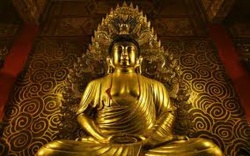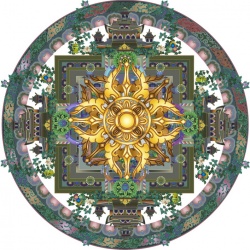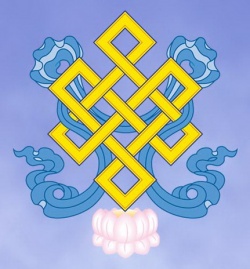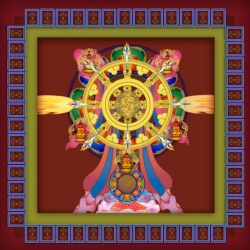Difference between revisions of "The Tree of Enlightenment: An Introduction to the Major Traditions of Buddhism - Chapter Twelve: The Five Aggregates"
m (Text replacement - "end" to "end") |
|||
| Line 1: | Line 1: | ||
{{DisplayImages|1041|2192|3332|2936|924|2179|3534|1267|1500}} | {{DisplayImages|1041|2192|3332|2936|924|2179|3534|1267|1500}} | ||
| + | |||
| + | |||
| + | |||
| + | |||
| + | |||
| + | |||
{{Centre|<big><big>The Tree of Enlightenment<br/> | {{Centre|<big><big>The Tree of Enlightenment<br/> | ||
An Introduction to the Major Traditions of Buddhism</big></big><br/> | An Introduction to the Major Traditions of Buddhism</big></big><br/> | ||
| Line 10: | Line 16: | ||
In the preceding chapters, I have several times had occasion to note that [[Buddhist teachings]] have been found relevant to {{Wiki|modern}} [[life]] and [[thought]] in the fields of [[science]], {{Wiki|psychology}}, and so forth. This is also the case for the analysis of personal [[experience]] in terms of the [[five aggregates]]. {{Wiki|Modern}} psychiatrists and {{Wiki|psychologists}} have been particularly [[interested]] in this analysis. It has even been suggested that, in the analysis of personal [[experience]] in terms of the [[five aggregates]], we have a [[psychological]] {{Wiki|equivalent}} to the table of [[elements]] worked out in {{Wiki|modern}} science--that is to say, a very careful inventory and {{Wiki|evaluation}} of the [[elements]] of our [[experience]]. | In the preceding chapters, I have several times had occasion to note that [[Buddhist teachings]] have been found relevant to {{Wiki|modern}} [[life]] and [[thought]] in the fields of [[science]], {{Wiki|psychology}}, and so forth. This is also the case for the analysis of personal [[experience]] in terms of the [[five aggregates]]. {{Wiki|Modern}} psychiatrists and {{Wiki|psychologists}} have been particularly [[interested]] in this analysis. It has even been suggested that, in the analysis of personal [[experience]] in terms of the [[five aggregates]], we have a [[psychological]] {{Wiki|equivalent}} to the table of [[elements]] worked out in {{Wiki|modern}} science--that is to say, a very careful inventory and {{Wiki|evaluation}} of the [[elements]] of our [[experience]]. | ||
| − | What we are going to do now is basically an extension and refinement of our analysis at the end of [[Chapter]] 11. There, we spent some [[time]] on the [[teaching]] of [[not-self]], exploring briefly the way the analysis of personal [[experience]] can be carried out along two lines: with regard to the [[body]], and with regard to the [[mind]]. You will recall that we examined the [[body]] and [[mind]] to see whether we could locate the [[self]], and saw that the [[self]] is not to be found in either of them. We concluded that the term "[[self]]" is just a convenient term for a collection of [[physical]] and [[mental factors]], in the same way that "{{Wiki|forest}}" is just a convenient term for a collection of [[trees]]. In this [[chapter]] we will take our analysis still further. Rather than looking at personal [[experience]] simply in terms of [[body]] and [[mind]], we will analyze it in terms of the [[five aggregates]]. | + | What we are going to do now is basically an extension and refinement of our analysis at the end of [[Chapter]] 11. There, we spent some [[time]] on the [[teaching]] of [[not-self]], exploring briefly the way the analysis of personal [[experience]] can be carried out along two lines: with regard to the [[body]], and with regard to the [[mind]]. You will recall that we examined the [[body]] and [[mind]] to see whether we could locate the [[self]], and saw that the [[self]] is not to be found in either of them. We concluded that the term "[[self]]" is just a convenient term for a collection of [[physical]] and [[mental factors]], in the same way that "{{Wiki|forest}}" is just a convenient term for a collection of [[trees]]. In this [[chapter]] we will take our analysis still further. Rather than [[looking at]] personal [[experience]] simply in terms of [[body]] and [[mind]], we will analyze it in terms of the [[five aggregates]]. |
| − | Let us first look at the [[aggregate]] of {{Wiki|matter}}, or [[form]]. The [[aggregate of form]] corresponds to what we would call material, or [[physical]], factors of [[experience]]. It includes not only our own [[bodies]] but also the [[material objects]] that surround us--the [[earth]], the [[trees]], the buildings, and the [[objects]] of everyday [[life]]. Specifically, the [[aggregate of form]] includes the five [[physical]] [[sense organs]] and the corresponding [[material objects]] of those [[sense organs]]: the [[eyes]] and [[visible]] [[objects]], the [[ears]] and audible [[objects]], the {{Wiki|nose}} and [[olfactory objects]], the {{Wiki|tongue}} and [[objects]] of {{Wiki|taste}}, and the {{Wiki|skin}} and [[tangible objects]]. | + | Let us first look at the [[aggregate]] of {{Wiki|matter}}, or [[form]]. The [[aggregate of form]] corresponds to what we would call material, or [[physical]], factors of [[experience]]. It includes not only our [[own]] [[bodies]] but also the [[material objects]] that surround us--the [[earth]], the [[trees]], the buildings, and the [[objects]] of everyday [[life]]. Specifically, the [[aggregate of form]] includes the five [[physical]] [[sense organs]] and the [[corresponding]] [[material objects]] of those [[sense organs]]: the [[eyes]] and [[visible]] [[objects]], the [[ears]] and audible [[objects]], the {{Wiki|nose}} and [[olfactory objects]], the {{Wiki|tongue}} and [[objects]] of {{Wiki|taste}}, and the {{Wiki|skin}} and [[tangible objects]]. |
But [[physical elements]] by themselves are not enough to produce [[experience]]. The simple [[contact]] between [[eyes]] and [[visible]] [[objects]], or [[ears]] and audible [[objects]], cannot result in [[experience]]. The [[eyes]] can be in {{Wiki|conjunction}} with a [[visible object]] indefinitely without producing [[experience]]; the [[ears]] can be exposed to a [[sound]] indefinitely with the same result. Only when the [[eyes]], a [[visible object]], and [[consciousness]] come together is the [[experience]] of a [[visible object]] produced. [[Consciousness]] is therefore an indispensable [[element]] in the production of [[experience]]. | But [[physical elements]] by themselves are not enough to produce [[experience]]. The simple [[contact]] between [[eyes]] and [[visible]] [[objects]], or [[ears]] and audible [[objects]], cannot result in [[experience]]. The [[eyes]] can be in {{Wiki|conjunction}} with a [[visible object]] indefinitely without producing [[experience]]; the [[ears]] can be exposed to a [[sound]] indefinitely with the same result. Only when the [[eyes]], a [[visible object]], and [[consciousness]] come together is the [[experience]] of a [[visible object]] produced. [[Consciousness]] is therefore an indispensable [[element]] in the production of [[experience]]. | ||
| − | Before we go on to our [[consideration]] of the [[mental factors]] of personal [[experience]], I would like to mention briefly the [[existence]] of one more set of an {{Wiki|organ}} and its [[object]], and here I speak of the sixth sense--the [[mind]]. This is in addition to the five [[physical]] [[sense organs]] ([[eyes]], [[ears]], {{Wiki|nose}}, {{Wiki|tongue}}, and {{Wiki|skin}}). Just as the five [[physical]] [[sense organs]] have their corresponding [[material objects]], the [[mind]] has for its [[object]] [[ideas]], or properties ([[dharmas]]). And as in the case of the five [[physical]] [[sense organs]], [[consciousness]] must be {{Wiki|present}} to unite the [[mind]] and its [[object]] so as to produce [[experience]]. | + | Before we go on to our [[consideration]] of the [[mental factors]] of personal [[experience]], I would like to mention briefly the [[existence]] of one more set of an {{Wiki|organ}} and its [[object]], and here I speak of the sixth sense--the [[mind]]. This is in addition to the five [[physical]] [[sense organs]] ([[eyes]], [[ears]], {{Wiki|nose}}, {{Wiki|tongue}}, and {{Wiki|skin}}). Just as the five [[physical]] [[sense organs]] have their [[corresponding]] [[material objects]], the [[mind]] has for its [[object]] [[ideas]], or properties ([[dharmas]]). And as in the case of the five [[physical]] [[sense organs]], [[consciousness]] must be {{Wiki|present}} to unite the [[mind]] and its [[object]] so as to produce [[experience]]. |
Let us now look at the [[mental factors]] of [[experience]] and see whether we can understand how [[consciousness]] turns the [[physical]] factors of [[existence]] into personal, [[conscious]] [[experience]]. First of all, we must remember that [[consciousness]] is mere [[awareness]] of, or mere sensitivity to, an [[object]]. When the [[physical]] factors of experience--for example, the [[eyes]] and a [[visible]] object--come into [[contact]], and when [[consciousness]], too, becomes associated with the material factors of [[experience]], [[visual consciousness]] arises. This is mere [[awareness]] of a [[visible object]], not anything like what we would normally call personal [[experience]]. Our everyday personal [[experience]] is produced through the functioning of the other three major [[mental factors]] of [[experience]]: the [[aggregate]] of [[feeling]], the [[aggregate of perception]], and the [[aggregate]] of [[Wikipedia:Volition (psychology)|volition]], or [[mental formation]]. These three [[aggregates]] [[function]] to turn this mere [[awareness]] of the [[object]] into personal [[experience]]. | Let us now look at the [[mental factors]] of [[experience]] and see whether we can understand how [[consciousness]] turns the [[physical]] factors of [[existence]] into personal, [[conscious]] [[experience]]. First of all, we must remember that [[consciousness]] is mere [[awareness]] of, or mere sensitivity to, an [[object]]. When the [[physical]] factors of experience--for example, the [[eyes]] and a [[visible]] object--come into [[contact]], and when [[consciousness]], too, becomes associated with the material factors of [[experience]], [[visual consciousness]] arises. This is mere [[awareness]] of a [[visible object]], not anything like what we would normally call personal [[experience]]. Our everyday personal [[experience]] is produced through the functioning of the other three major [[mental factors]] of [[experience]]: the [[aggregate]] of [[feeling]], the [[aggregate of perception]], and the [[aggregate]] of [[Wikipedia:Volition (psychology)|volition]], or [[mental formation]]. These three [[aggregates]] [[function]] to turn this mere [[awareness]] of the [[object]] into personal [[experience]]. | ||
| Line 28: | Line 34: | ||
You will notice that I have used the terms "[[Wikipedia:Volition (psychology)|volition]]" and "[[mental formation]]" together. This is because each of these terms represents one half of the meaning of the original term: [[mental formation]] represents the half that comes from the {{Wiki|past}}, and [[Wikipedia:Volition (psychology)|volition]] represents the half that functions here and now. [[Mental formation]] and [[Wikipedia:Volition (psychology)|volition]] work together to determine our responses to the [[objects]] of [[experience]], and these responses have [[moral]] {{Wiki|consequences}} in the [[form]] of [[wholesome]], [[unwholesome]], and [[neutral]] effects. | You will notice that I have used the terms "[[Wikipedia:Volition (psychology)|volition]]" and "[[mental formation]]" together. This is because each of these terms represents one half of the meaning of the original term: [[mental formation]] represents the half that comes from the {{Wiki|past}}, and [[Wikipedia:Volition (psychology)|volition]] represents the half that functions here and now. [[Mental formation]] and [[Wikipedia:Volition (psychology)|volition]] work together to determine our responses to the [[objects]] of [[experience]], and these responses have [[moral]] {{Wiki|consequences}} in the [[form]] of [[wholesome]], [[unwholesome]], and [[neutral]] effects. | ||
| − | We can now see how the [[physical]] and [[mental factors]] of [[experience]] work together to produce personal [[experience]]. To make this a little clearer, let us say that you decide to take a walk in the garden. As you walk, your [[eyes]] come into [[contact]] with a [[visible object]]. As your [[attention]] focuses on that [[object]], your [[consciousness]] becomes {{Wiki|aware}} of a [[visible object]] which is as yet {{Wiki|indeterminate}}. Your [[aggregate of perception]] then identifies that [[visible object]] as, let us say, a {{Wiki|snake}}. Once that happens, you respond to the [[object]] with the [[aggregate]] of feeling-the [[feeling]] of [[displeasure]]. Finally, you react to that [[visible object]] with the [[aggregate]] of [[Wikipedia:Volition (psychology)|volition]], with the intentional [[action]] of perhaps running away or picking up a stone. | + | We can now see how the [[physical]] and [[mental factors]] of [[experience]] work together to produce personal [[experience]]. To make this a little clearer, let us say that you decide to take a walk in the [[garden]]. As you walk, your [[eyes]] come into [[contact]] with a [[visible object]]. As your [[attention]] focuses on that [[object]], your [[consciousness]] becomes {{Wiki|aware}} of a [[visible object]] which is as yet {{Wiki|indeterminate}}. Your [[aggregate of perception]] then identifies that [[visible object]] as, let us say, a {{Wiki|snake}}. Once that happens, you respond to the [[object]] with the [[aggregate]] of feeling-the [[feeling]] of [[displeasure]]. Finally, you react to that [[visible object]] with the [[aggregate]] of [[Wikipedia:Volition (psychology)|volition]], with the intentional [[action]] of perhaps running away or picking up a stone. |
| − | In all our daily [[activities]], we can see how the [[five aggregates]] work together to produce personal [[experience]]. At this very moment, for instance, there is [[contact]] between two [[elements]] of the [[aggregate]] of form--the letters on the page and your [[eyes]]. Your [[consciousness]] becomes {{Wiki|aware}} of the letters on the page. Your [[aggregate of perception]] identifies the words that are written there. Your [[aggregate]] of [[feeling]] produces an [[emotional]] response--pleasure, [[displeasure]], or [[indifference]]. Your [[aggregate]] of [[Wikipedia:Volition (psychology)|volition]] responds with a [[conditioned]] reaction--sitting at [[attention]], {{Wiki|daydreaming}}, or perhaps yawning. We can analyze all our personal [[experience]] in terms of the [[five aggregates]]. | + | In all our daily [[activities]], we can see how the [[five aggregates]] work together to produce personal [[experience]]. At this very [[moment]], for instance, there is [[contact]] between two [[elements]] of the [[aggregate]] of form--the letters on the page and your [[eyes]]. Your [[consciousness]] becomes {{Wiki|aware}} of the letters on the page. Your [[aggregate of perception]] identifies the words that are written there. Your [[aggregate]] of [[feeling]] produces an [[emotional]] response--pleasure, [[displeasure]], or [[indifference]]. Your [[aggregate]] of [[Wikipedia:Volition (psychology)|volition]] responds with a [[conditioned]] reaction--sitting at [[attention]], {{Wiki|daydreaming}}, or perhaps [[yawning]]. We can analyze all our personal [[experience]] in terms of the [[five aggregates]]. |
| − | There is one point, however, that must be remembered about the [[nature]] of the [[five aggregates]], and that is that each of them is in [[constant]] change. The [[elements]] that constitute the [[aggregate of form]] are [[impermanent]] and are in a state of [[constant]] change. We discussed this in [[Chapter]] 11, when we noted that the [[body]] grows old, weak, and sick, and that the things around us are also [[impermanent]] and constantly changing. Our [[feelings]], too, are constantly changing. Today we may respond to a particular situation with a [[feeling]] of [[pleasure]]; tomorrow, with [[displeasure]]. Today we may {{Wiki|perceive}} an [[object]] in a particular way; later, under different circumstances, our [[perceptions]] will change. In semidarkness, we {{Wiki|perceive}} a rope to be a {{Wiki|snake}}; the moment the {{Wiki|light}} of a torch falls on that [[object]], we {{Wiki|perceive}} it to be a rope. | + | There is one point, however, that must be remembered about the [[nature]] of the [[five aggregates]], and that is that each of them is in [[constant]] change. The [[elements]] that constitute the [[aggregate of form]] are [[impermanent]] and are in a [[state]] of [[constant]] change. We discussed this in [[Chapter]] 11, when we noted that the [[body]] grows old, weak, and sick, and that the things around us are also [[impermanent]] and constantly changing. Our [[feelings]], too, are constantly changing. Today we may respond to a particular situation with a [[feeling]] of [[pleasure]]; tomorrow, with [[displeasure]]. Today we may {{Wiki|perceive}} an [[object]] in a particular way; later, under different circumstances, our [[perceptions]] will change. In semidarkness, we {{Wiki|perceive}} a rope to be a {{Wiki|snake}}; the [[moment]] the {{Wiki|light}} of a torch falls on that [[object]], we {{Wiki|perceive}} it to be a rope. |
Our [[perceptions]], like our [[feelings]] and like the [[material objects]] of our [[experience]], are ever-changing and [[impermanent]]; so, too, are our [[volitional]] responses. We can alter our [[habits]]. We can learn to be kind and [[compassionate]]. We can acquire the attitudes of [[renunciation]], [[equanimity]], and so forth. [[Consciousness]], too, is [[impermanent]] and constantly changing. [[Consciousness]] arises dependent on an [[object]] and a [[sense organ]]. It cannot [[exist]] {{Wiki|independently}}. As we have seen, all the [[physical]] and [[mental factors]] of our experience--like our [[bodies]], the [[physical objects]] around us, our [[minds]], and our ideas--are [[impermanent]] and constantly changing. All these [[aggregates]] are constantly changing and [[impermanent]]. They are {{Wiki|processes}}, not things. They are dynamic, not static. | Our [[perceptions]], like our [[feelings]] and like the [[material objects]] of our [[experience]], are ever-changing and [[impermanent]]; so, too, are our [[volitional]] responses. We can alter our [[habits]]. We can learn to be kind and [[compassionate]]. We can acquire the attitudes of [[renunciation]], [[equanimity]], and so forth. [[Consciousness]], too, is [[impermanent]] and constantly changing. [[Consciousness]] arises dependent on an [[object]] and a [[sense organ]]. It cannot [[exist]] {{Wiki|independently}}. As we have seen, all the [[physical]] and [[mental factors]] of our experience--like our [[bodies]], the [[physical objects]] around us, our [[minds]], and our ideas--are [[impermanent]] and constantly changing. All these [[aggregates]] are constantly changing and [[impermanent]]. They are {{Wiki|processes}}, not things. They are dynamic, not static. | ||
| Line 38: | Line 44: | ||
What is the use of this analysis of personal [[experience]] in terms of the [[five aggregates]]? What is the use of this reduction of the apparent {{Wiki|unity}} of personal [[experience]] into the [[elements]] of [[form]], [[feeling]], [[perception]], [[Wikipedia:Volition (psychology)|volition]] or [[mental formation]], and [[consciousness]]? The {{Wiki|purpose}} is to create the [[wisdom]] of [[not-self]]. What we wish to achieve is a way of experiencing the [[world]] that is not [[constructed]] on and around the [[idea]] of a [[self]]. We want to see personal [[experience]] in terms of processes--in terms of {{Wiki|impersonal}} functions rather than in terms of a [[self]] and what affects a self--because this will create an [[attitude]] of [[equanimity]], which will help us overcome the [[emotional]] {{Wiki|disturbances}} of {{Wiki|hope}} and {{Wiki|fear}} about the things of the [[world]]. | What is the use of this analysis of personal [[experience]] in terms of the [[five aggregates]]? What is the use of this reduction of the apparent {{Wiki|unity}} of personal [[experience]] into the [[elements]] of [[form]], [[feeling]], [[perception]], [[Wikipedia:Volition (psychology)|volition]] or [[mental formation]], and [[consciousness]]? The {{Wiki|purpose}} is to create the [[wisdom]] of [[not-self]]. What we wish to achieve is a way of experiencing the [[world]] that is not [[constructed]] on and around the [[idea]] of a [[self]]. We want to see personal [[experience]] in terms of processes--in terms of {{Wiki|impersonal}} functions rather than in terms of a [[self]] and what affects a self--because this will create an [[attitude]] of [[equanimity]], which will help us overcome the [[emotional]] {{Wiki|disturbances}} of {{Wiki|hope}} and {{Wiki|fear}} about the things of the [[world]]. | ||
| − | We {{Wiki|hope}} for [[happiness]], we {{Wiki|fear}} [[pain]]. We {{Wiki|hope}} for praise, we {{Wiki|fear}} blame. We {{Wiki|hope}} for gain, we {{Wiki|fear}} loss. We {{Wiki|hope}} for [[fame]], we {{Wiki|fear}} infamy. We live in a state of alternate {{Wiki|hope}} and {{Wiki|fear}}. We [[experience]] these [[Wikipedia:Hope|hopes]] and {{Wiki|fears}} because we understand [[happiness]], [[pain]], and so forth in terms of the [[self]]: we understand them as personal [[happiness]] and [[pain]], personal praise and blame, and so on. But once we understand them in terms of {{Wiki|impersonal}} {{Wiki|processes}}, and once--through this understanding--we get rid of the [[idea]] of a [[self]], we can overcome {{Wiki|hope}} and {{Wiki|fear}}. We can regard [[happiness]] and [[pain]], praise and blame, and all the rest with [[equanimity]], with even-mindedness. Only then will we no longer be [[subject]] to the imbalance of alternating between {{Wiki|hope}} and {{Wiki|fear}}. | + | We {{Wiki|hope}} for [[happiness]], we {{Wiki|fear}} [[pain]]. We {{Wiki|hope}} for praise, we {{Wiki|fear}} blame. We {{Wiki|hope}} for gain, we {{Wiki|fear}} loss. We {{Wiki|hope}} for [[fame]], we {{Wiki|fear}} infamy. We live in a [[state]] of alternate {{Wiki|hope}} and {{Wiki|fear}}. We [[experience]] these [[Wikipedia:Hope|hopes]] and {{Wiki|fears}} because we understand [[happiness]], [[pain]], and so forth in terms of the [[self]]: we understand them as personal [[happiness]] and [[pain]], personal praise and blame, and so on. But once we understand them in terms of {{Wiki|impersonal}} {{Wiki|processes}}, and once--through this understanding--we get rid of the [[idea]] of a [[self]], we can overcome {{Wiki|hope}} and {{Wiki|fear}}. We can regard [[happiness]] and [[pain]], praise and blame, and all the rest with [[equanimity]], with even-mindedness. Only then will we no longer be [[subject]] to the imbalance of alternating between {{Wiki|hope}} and {{Wiki|fear}}. |
Latest revision as of 12:51, 16 April 2024
The Tree of Enlightenment
An Introduction to the Major Traditions of Buddhism
Peter Della Santina
Chapter Twelve
The Five Aggregates
In this chapter we will look at the teaching of the five aggregates--form, feeling, perception, volition, and consciousness. In other words, we will look at the Buddhist analysis of personal experience, or the personality.
In the preceding chapters, I have several times had occasion to note that Buddhist teachings have been found relevant to modern life and thought in the fields of science, psychology, and so forth. This is also the case for the analysis of personal experience in terms of the five aggregates. Modern psychiatrists and psychologists have been particularly interested in this analysis. It has even been suggested that, in the analysis of personal experience in terms of the five aggregates, we have a psychological equivalent to the table of elements worked out in modern science--that is to say, a very careful inventory and evaluation of the elements of our experience.
What we are going to do now is basically an extension and refinement of our analysis at the end of Chapter 11. There, we spent some time on the teaching of not-self, exploring briefly the way the analysis of personal experience can be carried out along two lines: with regard to the body, and with regard to the mind. You will recall that we examined the body and mind to see whether we could locate the self, and saw that the self is not to be found in either of them. We concluded that the term "self" is just a convenient term for a collection of physical and mental factors, in the same way that "forest" is just a convenient term for a collection of trees. In this chapter we will take our analysis still further. Rather than looking at personal experience simply in terms of body and mind, we will analyze it in terms of the five aggregates.
Let us first look at the aggregate of matter, or form. The aggregate of form corresponds to what we would call material, or physical, factors of experience. It includes not only our own bodies but also the material objects that surround us--the earth, the trees, the buildings, and the objects of everyday life. Specifically, the aggregate of form includes the five physical sense organs and the corresponding material objects of those sense organs: the eyes and visible objects, the ears and audible objects, the nose and olfactory objects, the tongue and objects of taste, and the skin and tangible objects.
But physical elements by themselves are not enough to produce experience. The simple contact between eyes and visible objects, or ears and audible objects, cannot result in experience. The eyes can be in conjunction with a visible object indefinitely without producing experience; the ears can be exposed to a sound indefinitely with the same result. Only when the eyes, a visible object, and consciousness come together is the experience of a visible object produced. Consciousness is therefore an indispensable element in the production of experience.
Before we go on to our consideration of the mental factors of personal experience, I would like to mention briefly the existence of one more set of an organ and its object, and here I speak of the sixth sense--the mind. This is in addition to the five physical sense organs (eyes, ears, nose, tongue, and skin). Just as the five physical sense organs have their corresponding material objects, the mind has for its object ideas, or properties (dharmas). And as in the case of the five physical sense organs, consciousness must be present to unite the mind and its object so as to produce experience.
Let us now look at the mental factors of experience and see whether we can understand how consciousness turns the physical factors of existence into personal, conscious experience. First of all, we must remember that consciousness is mere awareness of, or mere sensitivity to, an object. When the physical factors of experience--for example, the eyes and a visible object--come into contact, and when consciousness, too, becomes associated with the material factors of experience, visual consciousness arises. This is mere awareness of a visible object, not anything like what we would normally call personal experience. Our everyday personal experience is produced through the functioning of the other three major mental factors of experience: the aggregate of feeling, the aggregate of perception, and the aggregate of volition, or mental formation. These three aggregates function to turn this mere awareness of the object into personal experience.
The aggregate of feeling, or sensation, is of three kinds--pleasant, unpleasant, and indifferent. When an object is experienced, that experience takes on one of these emotive tones, either the tone of pleasure, the tone of displeasure, or the tone of indifference.
Let us look next at the aggregate of perception. This is an aggregate that many people find difficult to understand. When we speak of perception, we have in mind the activity of recognition, or identification. In a sense, we are talking about attaching a name to an object of experience. The function of perception is to turn an indefinite experience into an identifiable, recognizable one. Here we are speaking of the formulation of a conception, or an idea, about a particular object. As with feeling, where we have an emotive element in the form of pleasure, displeasure, or indifference, with perception we have a conceptual element in the form of the introduction of a definite, determinate idea about the object of experience.
Finally, there is the aggregate of volition, or mental formation, which can be described as a conditioned response to the object of experience. In this sense it partakes of the meaning of habit as well. We spent some time discussing volition in Chapter 10, when we considered the twelve components of interdependent origination. You will remember that we described volition as the impressions created by previous actions, the habit energy stored up over the course of countless former lifetimes. Here, as one of the five aggregates, volition plays a similar role. But volition has not only a static value but also a dynamic value because, just as our present actions are conditioned by past actions, so our responses here and now are motivated and directed in a particular way by volition. Volition therefore has a moral dimension, just as perception has a conceptual dimension and feeling has an emotive dimension.
You will notice that I have used the terms "volition" and "mental formation" together. This is because each of these terms represents one half of the meaning of the original term: mental formation represents the half that comes from the past, and volition represents the half that functions here and now. Mental formation and volition work together to determine our responses to the objects of experience, and these responses have moral consequences in the form of wholesome, unwholesome, and neutral effects.
We can now see how the physical and mental factors of experience work together to produce personal experience. To make this a little clearer, let us say that you decide to take a walk in the garden. As you walk, your eyes come into contact with a visible object. As your attention focuses on that object, your consciousness becomes aware of a visible object which is as yet indeterminate. Your aggregate of perception then identifies that visible object as, let us say, a snake. Once that happens, you respond to the object with the aggregate of feeling-the feeling of displeasure. Finally, you react to that visible object with the aggregate of volition, with the intentional action of perhaps running away or picking up a stone.
In all our daily activities, we can see how the five aggregates work together to produce personal experience. At this very moment, for instance, there is contact between two elements of the aggregate of form--the letters on the page and your eyes. Your consciousness becomes aware of the letters on the page. Your aggregate of perception identifies the words that are written there. Your aggregate of feeling produces an emotional response--pleasure, displeasure, or indifference. Your aggregate of volition responds with a conditioned reaction--sitting at attention, daydreaming, or perhaps yawning. We can analyze all our personal experience in terms of the five aggregates.
There is one point, however, that must be remembered about the nature of the five aggregates, and that is that each of them is in constant change. The elements that constitute the aggregate of form are impermanent and are in a state of constant change. We discussed this in Chapter 11, when we noted that the body grows old, weak, and sick, and that the things around us are also impermanent and constantly changing. Our feelings, too, are constantly changing. Today we may respond to a particular situation with a feeling of pleasure; tomorrow, with displeasure. Today we may perceive an object in a particular way; later, under different circumstances, our perceptions will change. In semidarkness, we perceive a rope to be a snake; the moment the light of a torch falls on that object, we perceive it to be a rope.
Our perceptions, like our feelings and like the material objects of our experience, are ever-changing and impermanent; so, too, are our volitional responses. We can alter our habits. We can learn to be kind and compassionate. We can acquire the attitudes of renunciation, equanimity, and so forth. Consciousness, too, is impermanent and constantly changing. Consciousness arises dependent on an object and a sense organ. It cannot exist independently. As we have seen, all the physical and mental factors of our experience--like our bodies, the physical objects around us, our minds, and our ideas--are impermanent and constantly changing. All these aggregates are constantly changing and impermanent. They are processes, not things. They are dynamic, not static.
What is the use of this analysis of personal experience in terms of the five aggregates? What is the use of this reduction of the apparent unity of personal experience into the elements of form, feeling, perception, volition or mental formation, and consciousness? The purpose is to create the wisdom of not-self. What we wish to achieve is a way of experiencing the world that is not constructed on and around the idea of a self. We want to see personal experience in terms of processes--in terms of impersonal functions rather than in terms of a self and what affects a self--because this will create an attitude of equanimity, which will help us overcome the emotional disturbances of hope and fear about the things of the world.
We hope for happiness, we fear pain. We hope for praise, we fear blame. We hope for gain, we fear loss. We hope for fame, we fear infamy. We live in a state of alternate hope and fear. We experience these hopes and fears because we understand happiness, pain, and so forth in terms of the self: we understand them as personal happiness and pain, personal praise and blame, and so on. But once we understand them in terms of impersonal processes, and once--through this understanding--we get rid of the idea of a self, we can overcome hope and fear. We can regard happiness and pain, praise and blame, and all the rest with equanimity, with even-mindedness. Only then will we no longer be subject to the imbalance of alternating between hope and fear.
Continue Reading
Part One: The Fundamentals of Buddhism
- The Tree of Enlightenment: An Introduction to the Major Traditions of Buddhism - Chapter One: Buddhism: A Modern Perspective
- The Tree of Enlightenment: An Introduction to the Major Traditions of Buddhism - Chapter Two: The Pre-Buddhist Background
- The Tree of Enlightenment: An Introduction to the Major Traditions of Buddhism - Chapter Three: The Life of the Buddha
- The Tree of Enlightenment: An Introduction to the Major Traditions of Buddhism - Chapter Four: The Four Noble Truths
- The Tree of Enlightenment: An Introduction to the Major Traditions of Buddhism - Chapter Five: Morality
- The Tree of Enlightenment: An Introduction to the Major Traditions of Buddhism - Chapter Six: Mental Development
- The Tree of Enlightenment: An Introduction to the Major Traditions of Buddhism - Chapter Seven: Wisdom
- The Tree of Enlightenment: An Introduction to the Major Traditions of Buddhism - Chapter Eight: Karma
- The Tree of Enlightenment: An Introduction to the Major Traditions of Buddhism - Chapter Nine: Rebirth
- The Tree of Enlightenment: An Introduction to the Major Traditions of Buddhism - Chapter Ten: Interdependent Origination
- The Tree of Enlightenment: An Introduction to the Major Traditions of Buddhism - Chapter Eleven: The Three Universal Characteristics
- The Tree of Enlightenment: An Introduction to the Major Traditions of Buddhism - Chapter Twelve: The Five Aggregates
- The Tree of Enlightenment: An Introduction to the Major Traditions of Buddhism - Chapter Thirteen: The Fundamentals in Practice
Part Two: The Mahayana
- The Tree of Enlightenment: An Introduction to the Major Traditions of Buddhism - Chapter Fourteen: The Origins of the Mahayana Tradition
- The Tree of Enlightenment: An Introduction to the Major Traditions of Buddhism - Chapter Fifteen: The Lotus Sutra
- The Tree of Enlightenment: An Introduction to the Major Traditions of Buddhism - Chapter Sixteen: The Heart Sutra
- The Tree of Enlightenment: An Introduction to the Major Traditions of Buddhism - Chapter Seventeen: The Lankavatara Sutra
- The Tree of Enlightenment: An Introduction to the Major Traditions of Buddhism - Chapter Eighteen: The Philosophy of the Middle Way
- The Tree of Enlightenment: An Introduction to the Major Traditions of Buddhism - Chapter Nineteen: The Philosophy of Mind Only
- The Tree of Enlightenment: An Introduction to the Major Traditions of Buddhism - Chapter Twenty: The Development of Mahayana Philosophy
- The Tree of Enlightenment: An Introduction to the Major Traditions of Buddhism - Chapter Twenty-One: Mahayana Buddhism in Practice
- The Tree of Enlightenment: An Introduction to the Major Traditions of Buddhism - Chapter Twenty-Two: The Origins of the Vajrayana Tradition
Part Three: The Vajrayana
- The Tree of Enlightenment: An Introduction to the Major Traditions of Buddhism - Chapter Twenty-Three: Philosophical and Religious Foundations
- The Tree of Enlightenment: An Introduction to the Major Traditions of Buddhism - Chapter Twenty-Four: Methodology
- The Tree of Enlightenment: An Introduction to the Major Traditions of Buddhism - Chapter Twenty-Five: Myth and Symbolism
- The Tree of Enlightenment: An Introduction to the Major Traditions of Buddhism - Chapter Twenty-Six: Psychology, Physiology, and Cosmology
- The Tree of Enlightenment: An Introduction to the Major Traditions of Buddhism - Chapter Twenty-Seven: The Preliminary Practices
- The Tree of Enlightenment: An Introduction to the Major Traditions of Buddhism - Chapter Twenty-Eight: The Vajrayana Initiation
- The Tree of Enlightenment: An Introduction to the Major Traditions of Buddhism - Chapter Twenty-Nine: Vajrayana Buddhism in Practice
- The Tree of Enlightenment: An Introduction to the Major Traditions of Buddhism - Chapter Thirty: An Introduction to the Abhidharma
Part Four: The Abhidharma
- The Tree of Enlightenment: An Introduction to the Major Traditions of Buddhism - Chapter Thirty-One: Philosophy and Psychology in the Abhidharma
- The Tree of Enlightenment: An Introduction to the Major Traditions of Buddhism - Chapter Thirty-Two: Methodology
- The Tree of Enlightenment: An Introduction to the Major Traditions of Buddhism - Chapter Thirty-Three: Analysis of Consciousness
- The Tree of Enlightenment: An Introduction to the Major Traditions of Buddhism - Chapter Thirty-Four: The Form and Formless Spheres
- The Tree of Enlightenment: An Introduction to the Major Traditions of Buddhism - Chapter Thirty-Five: Supramundane Consciousness
- The Tree of Enlightenment: An Introduction to the Major Traditions of Buddhism - Chapter Thirty-Six: Analysis of Mental States
- The Tree of Enlightenment: An Introduction to the Major Traditions of Buddhism - Chapter Thirty-Seven: Analysis of Thought-Processes
- The Tree of Enlightenment: An Introduction to the Major Traditions of Buddhism - Chapter Thirty-Eight: Analysis of Matter
- The Tree of Enlightenment: An Introduction to the Major Traditions of Buddhism - Chapter Thirty-Nine: Analysis of Conditionality
- The Tree of Enlightenment: An Introduction to the Major Traditions of Buddhism - Chapter Forty: The Thirty-Seven Factors of Enlightenment
- The Tree of Enlightenment: An Introduction to the Major Traditions of Buddhism - Chapter Forty-One: Abhidharma in Daily Life








